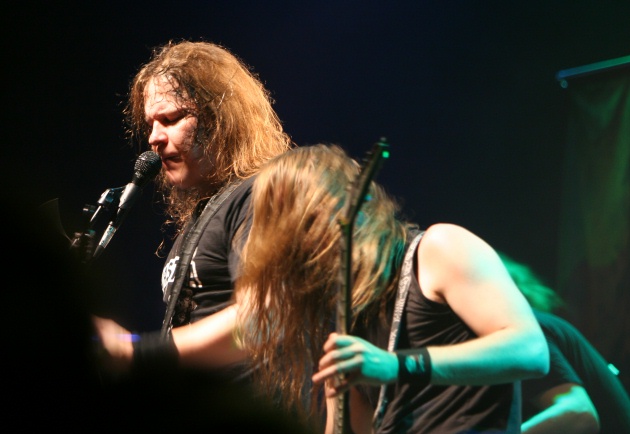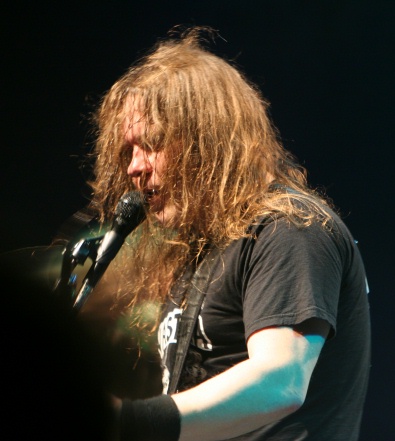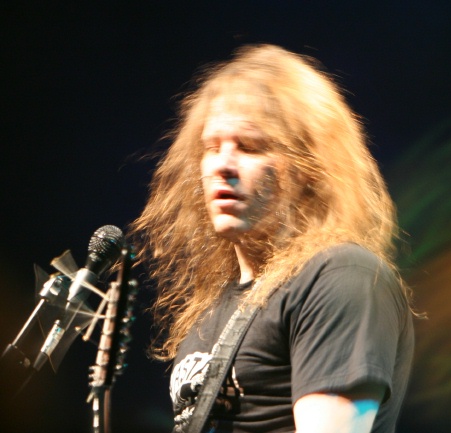Rainer Nygård of Diablo
by Alissa Ordabai
Staff Writer
 Who would have thought that true American metal, born out of Bay Area heat at the start of the most opulent decade of the 20th century, and fostered by the region’s bohemian habits, natural beauty, and massive network of roads, would sprout seeds that would later bud on soil as remote from California’s splendour as Henry James is from Elder Edda? But when Scandinavians took to metal as thoroughly and as enthusiastically as if they have invented it, the initial shock was followed by resignation – we all know that metal has two strongholds now – its birthplace in the US and its adopted home in Scandinavia.
Who would have thought that true American metal, born out of Bay Area heat at the start of the most opulent decade of the 20th century, and fostered by the region’s bohemian habits, natural beauty, and massive network of roads, would sprout seeds that would later bud on soil as remote from California’s splendour as Henry James is from Elder Edda? But when Scandinavians took to metal as thoroughly and as enthusiastically as if they have invented it, the initial shock was followed by resignation – we all know that metal has two strongholds now – its birthplace in the US and its adopted home in Scandinavia.
The closer you look, the less mysterious the phenomenon appears to be. Weather, history and geography apart, it is the liberal tradition shared by Bay Area and Scandinavia that links them to each other, as well as their affluence, and the hunger of their young for finding answers beyond the mundane realities of prosperity and comfort. It is now a truism that behind the New Age tranquillity and Hollywood gloss of the conventional Californian façade a sinister shadow has always been lurking, something which the Manson murders have exposed so brutally, and which never found true expression and valid release until the emergence of heavy metal. The shadow which used to lurk behind the fragrant orange trees, hide in the glare of midnight beach fires and in the back rooms of San Francisco handicraft shops, the shadow which haunted the campuses of elite universities, or waited curled up in the back leather seats of chrome masterpieces of luxury showrooms, this phantom never went away until in the early Eighties it shed its ghostly connotations and burst forth in all the glory of what it really was. And what exactly was it? At once simple and vexing, it was the frustration and the disgust with the stagnation, the hypocrisy, the artificiality, the vacuity, the banality, the arrogance of the affluent and the mindless, with everything that petty-bourgeoisie stands for, the frustration that thrash gave voice to so beautifully and so boldly, in a way Charlie Manson would never have dared to imagine with his poisoned mind.
And once it happened, the wealthiest, most stable part of Europe responded in a way that left us all gawping in awe. It wasn’t just a handful of bands that began emerging from Finland, Sweden, and Norway, it was an avalanche, as if the floodgates that have been shut for years have finally opened. These days Scandinavia boasts as many, if not more, metal bands as Bay Area did in the early Eighties – brutal and sophisticated, traditional and experimental, popular and obscure, spanning so many genres that the rest of the world doesn’t always manage to keep up.
The story of Diablo charts this development perfectly. Four Finnish lads who in mid-Nineties started out with worshipping early American thrash heroes, have now become a force of their own, idolised in their home country where they have been steadily topping the charts since 2004. Now they are beginning to showcase their material to the rest of the world. Their most recent record, “Icaros”, released last May has recently been presented to the rest of Europe on Diablo’s February tour with Children of Bodom and Cannibal Corpse. An intense, moving record, it has been described by the band as their best effort so far, which isn’t surprising because it sums up better than its predecessors the musical paradigm which is both archetypically Scandinavian but at the same time uniquely Diablo’s own. What could be more Scandinavian than the multi-layered textures of sound where roiling intensity of ferocious riffs and explosive rhythmic grooves contrast with the haunting, forlorn melodies that bring to mind dark, eerie legends where one skis after the Demon’s elk through the depth of the Finnish forest, quells the wolves, and follows the Maid of the North down the Karelian stream. One poignant detail after another takes you on a trip so singular you soon forget where thrash ends and Norse witchery begins. And, above all, it shows how all the lessons taught by the pioneers of metal and their Nineties followers, have been absorbed and reworked into a deep-voiced, confident unified whole, a unique vision that marks Diablo out dozens of other bands of their pedigree.
 Hardrock Haven caught up with Diablo’s singer Rainer Nygård in the middle of this tour, hours before the band’s first ever London show at the Forum, the best 2000-seater of the UK capital.
Hardrock Haven caught up with Diablo’s singer Rainer Nygård in the middle of this tour, hours before the band’s first ever London show at the Forum, the best 2000-seater of the UK capital.
Hardrock Haven: How are you finding England? Have you been here before?
Rainer Nygård: Never. Not even as a tourist. But so far, so good.
HRH: Have you managed to see any of the town?
RN: Yeah, a little bit, but I just went to eat some breakfast early in the morning, but no sightseeing.
HRH: You’ve done some South European dates just before you hit London, and some England dates too.
RN: Yeah, we also did Germany, Hungary, Switzerland, Austria, Italy and Holland before we did England. We also did Glasgow in Scotland and then came down to England. Yesterday we were in Portsmouth, in Southern England.
HRH: Would you say there is a contrast between playing Southern Europe and Northern Europe?
RN: There is. We are not a very famous band, at least for the moment…
HRH: But you are huge in Finland.
RN: Yes, but Finland is Finland, it’s different. But in Italy we had the wildest audience ever so far.
HRH: A lot of people say that Italy is the most enthusiastic audience for metal.
RN: Also Hungary was good.
HRH: That’s probably because the Eastern block’s been starved of rock’n’roll for so many years.
RN: Maybe! But those gigs were really great. You have to keep in mind that for them we are a relatively unknown band.
HRH: You are touring with two acts this time around – Children of Bodom and Cannibal Corpse. In terms of musical knowledge, is there anything you adapt from the bands you come in touch with this way?
RN: Not really. All three bands are metal, but we represent three entirely different directions. Cannibal Corpse is quite brutal and very technical death metal, and Bodom is Bodom. (Laughs.) You know, the keyboards and all that. But our roots are in the Eighties thrash metal bands like Testament and Slayer. But still we are very much into melodies. We are a combination, I can sing in a pure voice and I can do growling, so I use at least two different styles when I perform. Or maybe more. (Laughs.) I can sing pure notes and I can sing notes with a crunch.
HRH: What elements, do you think, need to coincide for a good live performance to happen?
RN: A good life performance? (Laughs.) It’s so hard to explain because to me it’s so simple – you go on the stage and play as well as you can, show your attitude to the people, which is almost like, “I’m the lord here.” Or you can go on the stage and watch your boots and go, “I’m so sorry that I’m here.” (Laughs.) It’s all about attitude.
HRH: How much of the new album are you showcasing on this tour?
RN: It depends on the length of the set that we can play. Five to six usually.
HRH: Are you happy with the way the new album has turned out?
RN: The reception in Finland has been great, but here it’s a different story because people don’t know us that well. But so far the audience has been positive and no one’s thrown any beers on the stage. (Laughs.)
HRH: Maybe it’s a silly question to ask…
RN: Go for it!
HRH: If you were given a chance to go back in time and change something on “Icaros”, would you do that? And is so, what then?
RN: Not really. The only thing is that I wish we had a little bit more time for the pre-production process. We were in quite a hurry when we were mixing and producing the album, but my true opinion is that “Icaros” is our strongest album so far. We play those songs live right now and each of them tells you something. We like those songs ourselves.
HRH: Are there any favourites?
RN: “Living Dead Superstar” is one, then there is “Icaros”, the title song, and “Into the Sea”. It has elements of industrial, but it’s not quite an industrial number, it’s a very strange atmosphere about that number, especially in the lyrics.
HRH: I was going to ask you about the lyrics. On “Living Dead Superstar” you are very open about modern popular culture obsessions. One line goes, “Behold the disciple of tyranny and fame.” What is the band’s relationship with the notion of fame?
RN: Quite strict. I only do these promotions for certain reasons, like today I’m here because we are playing. But when I’m off duty in my home town, I never go, “Don’t you know who I am?” to get into a restaurant or something. I keep a very low profile. And I hate modern style like in Finland where these bimbos go to see politicians and then sell their stories to magazines. I can’t stand that.
HRH: How do you feel about this trend these days when it’s not only people with a certain talent, but people utterly devoid of any talent who still aspire to be famous?
RN: That’s the point. That’s what I mean.
HRH: Tell me about Finland.
RN: (Laughs.) It’s cold out there.
HRH: But what really intrigues people from the rest of the world is the way in which Scandinavia has managed to come up with such a unique interpretation of heavy metal, a genre which was born in sunny California. Where do those dark, haunting melodies come from in the music of so many Finnish bands?
RN: I guess it has something to do with Finland’s proximity to Russia. You know, when it’s dark and cold outside, and those guys are sitting there getting drunk entertaining gloomy thoughts.
HRH: Apart from this very recognisable Scandinavian mood you also have very pronounced early thrash influences. How do you manage to combine such a variety of influences into such a seamless whole?
RN: When we were just learning how to play music, we did try to take a lot of bands as an example to follow, but today we don’t think what we should sound like. We just make music and we don’t care about following modern trends.
HRH: But you still manage to sound very up-to-date. And, surprisingly, the new album shows that you are also the children of the Nineties. On the first track on your new album you can hear nu-metal influences.
RN: On “Icaros”?
HRH: Yes, the new album. The drumming on the first track is very nu-metal. What is your relationship with this style?
RN: Bands like?..
HRH: Slipknot, Korn, System of a Down.
RN: Korn made a least one good record. System of a Down are good but not my cup of tea. Slipknot, OK, I can relate to their attitude and that great mask thing act, the visual aspect of it, I can relate to that, but I wouldn’t say those bands were a big influence on us. Maybe something has seeped through on us from those bands but we don’t even recognise that.
HRH: Right, a subconscious influence then.
RN: Yeah.
HRH: But how do you manage to take all those influences and unify them into one coherent whole?
RN: I don’t know, and, by the way, I’m not the best person to answer that question because Marko (Marko Utriainen, guitarist) writes most of the music and I write about ten per cent and I write the lyrics, and we arrange those songs together, we piece the lyrics and the arrangements and so on. But I can see that Marko doesn’t think about those things too much. He just plays his guitar and when he finds a good melody or a good riff he just puts it down.
HRH: How long did it take you to write the material for the album?
RN: In the end, when we just entered the studio, we worked really fast, but it takes a year to collect the right riffs and to write the concept for the album. It takes another year to put that into real music and real songs. And the last two months before entering the studio is the hardest part, this is where you put the lyrics together and so on. Two years.
HRH: Do you write lyrics together?
RN: No, I write them alone.
 HRH: What’s your inspiration for your lyrics?
HRH: What’s your inspiration for your lyrics?
RN: Just take a newspaper and you see the inspiration, there it comes! (Laughs.) I cannot explain that any better. On the “Icaros” album the main influence for the concept – the overall concept including the booklet and so on – came from an old Finnish movie called “Eight Deadly Bullets”.
HRH: A horror?
RN: It’s not a horror, it’s about a real event that happened in Finland in 1969 when one guy shot four policemen.
HRH: But the artwork is haunting, this little hut in the middle of the woods, the creepy interior…
RN: Those are stills from the movie. Not from the place where the shooting took place, but a similar kind of place.
HRH: You’ve been in this business for such a long time now, you’ve seen trends come and go. What do you think is the future of metal? How, do you think, the genre will progress?
RN: I’ll say that good bands will survive no matter what.
HRH: But what is your take on the changes that are happening now in the music industry? Things like MySpace, YouTube, free downloads?
RN: That’s a tricky question because those uploading systems on the net are negatively affecting the record sales, and those sales are very important because without those sales we can’t go on tour and so on. But MySpace and YouTube are only good for us because people can check our shows that way. I have met many young people in England during this week who saw us for the first time on YouTube.
HRH: So that way you get promotion that MTV would never give to a metal act.
RN: Yes, but YouTube does that.
HRH: Well, listen, I have one last question and it’s a bit goofy, but I hope you don’t mind. If you were given an answer to any question in the universe, what would you ask?
RN: Does God really exit? Because I don’t believe in God.
